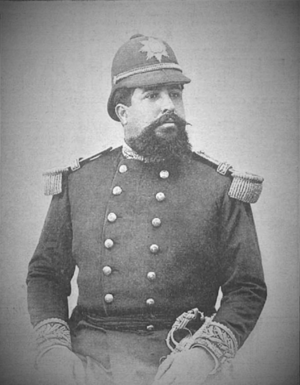Carlos Ezeta facts for kids
Quick facts for kids
General
Carlos Ezeta
|
|
|---|---|
 |
|
| 18th President of El Salvador | |
| In office 22 June 1890 – 10 June 1894 Provisional: 22 June 1890 – 1 March 1891 |
|
| Vice President | Antonio Ezeta (1891–1894) |
| Preceded by | Francisco Menéndez |
| Succeeded by | Rafael Antonio Gutiérrez |
| Personal details | |
| Born | 14 June 1852 San Salvador, El Salvador |
| Died | 21 March 1903 (aged 50) Mazatlán, Mexico |
| Political party | Liberal |
| Spouse | Josefa Marroquín |
| Children | 4 |
| Relatives | Antonio Ezeta (brother) |
| Profession | Military |
| Military service | |
| Allegiance | |
| Branch/service | Salvadoran Army |
| Years of service | 1872–1894 |
| Rank | General |
| Battles/wars | Barrios' War of Reunification First Totoposte War Revolution of the 44 |
Carlos Basilio Ezeta y León was a military leader who became the President of El Salvador. He was born on June 14, 1852, in San Salvador, El Salvador. He served as president from June 1890 to June 1894. Carlos Ezeta was removed from power in 1894 and passed away in 1903 at the age of 50.
Contents
Early Life of Carlos Ezeta
Carlos Ezeta was born in San Salvador, El Salvador, on June 14, 1852. His father was General Eligió Ezeta. Carlos had a younger brother named Antonio Ezeta. He later married Josefa Marroquín. Together, they had four children.
Military Career
Carlos Ezeta joined the Salvadoran Army. He fought in battles when Honduras was invaded in 1872 and 1873. During his time in the army, he was injured in a battle in Santa Bárbara.
He lived in Costa Rica for a short time in 1875. He then returned to El Salvador in 1876. Later, he visited the United States and Guatemala. In 1885, he came back to El Salvador to fight against Guatemala in a conflict known as Barrios' War of Reunification. He also took part in the Battle of Chalchuapa.
Becoming President
On June 22, 1890, Carlos Ezeta led an uprising. This event led to the overthrow of the current President, General Francisco Menéndez. Ezeta then took control.
On March 1, 1891, Carlos Ezeta officially became the President of El Salvador. This happened after he won the 1891 Salvadoran presidential election.
Time as President
During Ezeta's time as president, El Salvador was quite stable politically. This was important because neighboring countries like Honduras and Guatemala were at war.
However, Carlos Ezeta eventually lost support from important landowners. Because of this, he was removed from power on June 9, 1894. This event is known as the Revolution of the 44. Rafael Antonio Gutiérrez led this revolution with help from Nicaragua, Guatemala, and Honduras.
Later Life and Death
After being overthrown, Carlos Ezeta left El Salvador. He first went to Panama. Then, he traveled to Europe because there was a warrant for his death.
Later, he returned to Central America. He eventually settled in Mazatlán, Mexico. Carlos Ezeta passed away there on March 21, 1903, at the age of 50. His remains are buried in the Angela Peralta Cemetery in Mazatlán.
See also
 In Spanish: Carlos Ezeta para niños
In Spanish: Carlos Ezeta para niños

